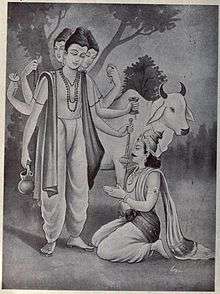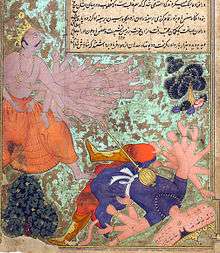Kartavirya Arjuna
Kartavirya Arjuna (Sanskrit: कार्तवीर्य अर्जुन, Kārtavīrya Arjuna; also known as Sahasrabahu Arjuna or Sahasrarjuna) was a legendary king of an ancient Haihayas kingdom with capital at Mahishmati which is on the banks of Narmada River in the current state of Madhya Pradesh. Kartavirya was son of Kritavirya, king of the Haihayas. According to the Puranas, Haihaya was the grandson of Sahasrajit, son of Yadu. This is his patronymic, by which he is best known; he is also referred to simply as Arjuna. He is described as having a thousand hands and a great devotee of god Dattatreya. One of the several such accounts states that Arjuna conquered Mahishmati city from Karkotaka Naga, a Naga chief and made it his fortress-capital.[1]
| Kartavirya Arjuna | |
|---|---|
 Dattatreya gives boon to Arjuna |
Arjuna Kartavirya is not to be confused with Arjuna Pandava, another major character in the Mahabharata.[2] Kartavirya Arjuna was the longest ruling Chakravati Samrat of Vedic era.

Names
- Arjuna- Birth name
- Kartavirya/Kartavirya arjuna- Son of Kritvirya
- Mahishmati Naresh- King of Mahishmati
- Sahastrabahu/Sahasrarjun/Sahastrabahu Kartavirya/Sahastrabahu Kartavirya Arjuna- One who had 1000 arms
- Sudarshan Chakravatar- Incarnation of Lord Sudarshan Chakra (The Celestial disc of Lord Vishnu)
- Sapt Dwipeshwar- Emperor of 7 Continents
- Dashgrivjayi- Conqueror of Ravana
- Raj Rajeshwar- King of kings
Allies
Kartavirya Arjuna had an ally of 1000 Akshauhinis. This was also a reason of his name Sahasrabahu where his ally is considered to be his arms.
Encounter with Ravana

Kartavirya's power is popularly told in the Ramayana, Uttara Kanda, which is not often considered to be the part of the original Valmiki Ramayana and its constituent 6 adhyayas (अध्याय), since the original Ramayana speaks of the number of verses and the shlokas in Ramayana - Verse 2 of Chapter IV of Baala Kaanda of Srimad Valmiki Ramayana reads as under:
चतुर्विंशत्सहस्त्राणि श्लोकानामुक्तवानृषिः | तथा सर्गशतान् पञ्च षट्काण्डानि तथोत्तरम् ||
This epic contains 24,000 verses split into 500 chapters in Six Cantos. (Baala Kaanda: refer Ch IV:2) [The six cantos are Baala Kaanda, Ayodhya Kaanda, Aranya Kaanda, Kishkinda Kaanda, Sundara (Lanka) Kaanda and Yuddha Kaanda.][3][4].
Kartavirya is considered to be the contemporary of Ravana. The story goes that once when Kartavirya Arjuna was having a bath in the river Narmada along with his wives, he stopped the force of the river with his thousand arms from both sides. The teenage Dasagriva (Ravana), who was singing the hymns of Shiva and praying to him, made him lose his concentration. Enraged, he challenged the former for combat in which Ravana was defeated and was put to humiliation. Then, on request of his paternal grandfather Pulastya the great emperor Arjuna released Ravana.
Another account states that when Ravana came "in the course of his campaign of conquest to Mahishmati (the capital of Kartavirya), he was captured without difficulty, and was confined like a wild beast in a corner of his city."
The Vayu Purana states that Kartavirya invaded Lanka, and there took Ravana as prisoner, but later he was killed by Parashurama and Ravana was rescued from Arjuna.[5]
Encounter with Parashurama

In the Mahabharata Vana Parva, according to the story of Akritavana, Kartavirya Arjuna became drunk with power, despite all the boons he had acquired. He lost control of his senses and began to oppress humans, Yakshas and the very gods themselves. Kartavirya even had the audacity to insult Indra in front of Shachi. Around this time, other Kshatriyas too had become drunk with power and oppressed innocents for pleasure.
Arjuna once troubled Varuna and asked him if there was anyone equal to him in power. Varuna replied that only Jamadagni's son, Parashurama rivalled Arjuna. Enraged, Arjuna went to Jamadagni's hermitage to see Parashurama's power.
The Puranas recount that Kartavirya Arjuna and his army visited a rishi named Jamadagni, who fed his guest and the whole army with offerings from his divine cow Kamadhenu. The king demanded the cow for the betterment of his subjects; Jamadagni refused because he needed the cow for his religious ceremonies. King Arjuna sent his soldiers to take the cow. As the conflict developed among the Jamadagni and the King, Arjuna lost his temper and chopped off the head of Jamadagni. When Parashurama (Jamadagni's son and one of the Daśāvatāras of Vishnu) returned to the hermitage, he was informed of the context by his mother. In revenge, Parashurama killed the entire clan of Arjuna and the King with a battleaxe given to him by Shiva, thus conquering the entire earth, which he gave to Brahamanas.
In another legend, Kartavirya Arjuna visited the hermitage of Jamadagni, and was received by that sage's wife Renuka with all respect; but he made an ill return for her hospitality, and carried off by violence "the calf of the milch-cow of the sacred oblation." For this outrage Parashurama cut off his thousand arms and killed him.
In another legend, Kartavirya sent seventeen Akshauhinis to fight against the alone Parashurama who was on foot. The Brahmana single-handedly slew the entire army and spared no one alive. Kartavirya arrived in his divine golden chariot which could go anywhere unobstructed. The King himself was a powerful archer, capable of simultaneously wielding five hundred bows and shooting five hundred arrows at a time. Parashurama broke Arjuna's bows, slew his horses and charioteer and destroyed the chariot itself with his arrows.
Arjuna hurled many weapons, rocks and trees at Parashurama, but the sage parried all these. Parashurama hacked off his thousand arms with his arrows and dismembered him with his axe.
In another place a different character is given to him, and more in accordance with his behavior at Jamadagni's hut. "He oppressed both men and gods," so that the latter appealed to Vishnu for succor. That God then came down to the earth as Parashurama for the special purpose of killing him.[6]
The Mahabharata mentions him as one of the best warriors and introduces his divine origin, attributing it to the Padmini Ekadasi. It is said that there was none who could rival him in Sacrifices, Charity, Learning, Austerity, Battlefield Exploits, Feats, Strength, Mercy, Generosity or Power.
In the controversy regarding his name the clarification is given as below; Sahasra[7] is the correct prefix that means "a thousand", not SahasTra. However, it is invariably misspelled as the latter. The same prefix is spelled when referring to the crown chakra: "Sahasrara Chakra" or when it occurs in family names (example: Sahasrabuddhe) without a T. Also see Sahasralinga. The confusion arises because the Hindi letter "Sa" (स) merges with "ra" (र) and looks like "tra".
The origin of Vrishala Kshatriya
The Ocean said, If thou hast heard, O king, of the great Rishi Jamadagni, his son is competent to duly receive thee as a guest.--Then that king proceeded, filled with great wrath. Arrived at that retreat, he found Rama himself. With his kinsmen he began to do many acts that were hostile to Rama, and caused much trouble to that high-souled hero. Then the energy, which was immeasurable of Rama blazed forth, burning the troops of the foe, O lotus-eyed one. Taking up his battle-axe, Rama suddenly put forth his power, and hacked that thousand-armed hero, like a tree of many branches. Beholding him slain and prostrated on the earth, all his kinsmen, uniting together, and taking up their darts, rushed at Rama, who was then seated, from all sides. Rama also, taking up his bow and quickly ascending on his car, shot showers of arrows and chastised the army of the king. Then, some of the Kshatriyas, afflicted with the terror of Jamadagni's son, entered mountain-fastnesses, like deer afflicted by the lion. Of them that were unable, through fear of Rama, to discharge the duties ordained for their order, the progeny became Vrishalas owing to their inability to find Brahmanas. 1 In this way Dravidas and Abhiras and Pundras, together with the Savaras, became Vrishalas through those men who had Kshatriya duties assigned to them (in consequence of their birth), falling away (from those duties). Then the Kshatriyas that were begotten by.[8]
Later on, as Patanjali's Aṣṭādhyāyī mentions, Abhiras appear in 150 BC. Later on, Abhiras established the Traikutaka dynasty with kings such as Ishwarsena, Indradutta, Dahrasena & Vyaghrasena. Dahrasena even performed Ashwamedha Yagya.[9] Traikutikas were known for their Vaishnava faith, who claimed to be Yadav of Haiheya branch[10] Later on, in 10th century, Chudasamas are mentioned as the Abhira Ranaka, in Hemachandra's reference to Graharipu in Dvyashraya. Merutunga claims in his prose that Abhira Ranaka, Navaghana defeated Jayasimha eleven times, but Jayasimha went himself twelfth time after capturing newly fortified Vardhamanapura (now Wadhwan).[11]
References
- Pargiter, F.E. (1972) [1922]. Ancient Indian Historical Tradition, Delhi: Motilal Banarsidass, p.265-7
- Lynn Thomas (2014). Julia Leslie (ed.). Myth and Mythmaking: Continuous Evolution in Indian Tradition. Routledge. pp. 64–66 with footnotes. ISBN 978-1-136-77881-0.
- "The Beauty of the Valmiki Ramayana by Bibek Debroy". Penguin. Penguin.
- "Why Ramayana's 'Uttar Kanda' should not be overlooked?". Business Standard.
- Dowson, John (1984). A Classical Dictionary of Hindu Mythology, and Religion, Geography, History. Calcutta: Rupa & Co. pp. 151–2.
- Gopal, Madan (1990). K.S. Gautam (ed.). India through the ages. Publication Division, Ministry of Information and Broadcasting, Government of India. p. 74.
- "Sahasra".
- Vyas, Ved (1883–96) [9th century BC]. Ashwamedha Parva - Mahabharata. Translated by Gangul, Kisari Mohan. Publication Division, Ministry of Information and Broadcasting, Government of India. p. SECTION XXIX.
- Sailendra Nath Sen (1 January 1999). Ancient Indian History and Civilization. New Age International. pp. 426–. ISBN 978-81-224-1198-0. Retrieved 3 January 2011.
- Gazetteer of the Bombay Presidency ..., Volume 1, Part 1 By Bombay (India : State), p. 58
- Asoke Kumar Majumdar 1956, p. 116.
- Asoke Kumar Majumdar (1956). Chaulukyas of Gujarat. Bharatiya Vidya Bhavan. OCLC 4413150.CS1 maint: ref=harv (link)
